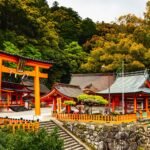Japanese Art Forms: From Traditional Calligraphy to Modern Art
- By -Maria Mash
- Posted on
- Posted in Culture
Japanese art reflects the country’s rich history and diverse culture. From ancient calligraphy to cutting-edge modern art, each form tells a unique story. Understanding these art styles can deepen your appreciation of Japan’s heritage and creative spirit. Let’s explore some of the most iconic Japanese art forms, both traditional and modern.
1. Traditional Calligraphy: Shodo
Shodo, or Japanese calligraphy, is more than writing; it’s an art form. Artists use brushes and ink to create beautiful characters on paper. The flow of each stroke expresses emotion and intent. Calligraphers focus on balance, rhythm, and the use of space. Practicing Shodo requires patience and precision. This ancient art continues to inspire modern artists, keeping the tradition alive in new ways.

2. Ikebana: The Art of Flower Arrangement
Ikebana transforms flowers into artistic expressions. Unlike typical flower arranging, Ikebana focuses on harmony, balance, and simplicity. The arrangement often includes leaves, branches, and stems to highlight nature’s beauty. Every element has meaning, and the empty space around the flowers plays an important role. Ikebana reflects the seasons, the passage of time, and the importance of nature in Japanese culture.
3. Ukiyo-e: Woodblock Prints
Ukiyo-e, or “pictures of the floating world,” flourished during the Edo period. Artists carved images onto wooden blocks, inked them, and pressed them onto paper. These prints depicted landscapes, kabuki actors, and scenes of everyday life. Ukiyo-e became popular in the West and influenced many European artists. Today, these prints remain a symbol of Japan’s artistic heritage and continue to captivate art lovers worldwide.
4. Kintsugi: The Art of Repairing with Gold
Kintsugi repairs broken pottery with lacquer mixed with powdered gold, silver, or platinum. This art form treats breakage as part of the history of an object rather than something to hide. The visible repairs add beauty and uniqueness to the piece. Kintsugi teaches the philosophy of embracing imperfections, which reflects broader aspects of Japanese culture.
5. Sumi-e: Ink Painting
Sumi-e, or ink painting, emphasizes simplicity and the essence of the subject. Artists use black ink on paper or silk to create expressive images, often of nature. The technique requires mastery of brush control and the ability to convey emotion through minimal lines. Sumi-e captures the spirit of the subject rather than just its appearance, highlighting the artist’s connection to nature.
6. Contemporary Japanese Art
Modern Japanese art blends tradition with innovation. Contemporary artists often draw on traditional techniques while exploring new themes and mediums. Takashi Murakami, for example, combines pop culture with traditional Japanese art styles, creating vibrant works that challenge the boundaries of art. Yayoi Kusama, known for her polka dots and immersive installations, explores themes of infinity and self-obliteration. These artists continue to shape the global art scene, reflecting Japan’s evolving culture.
7. Manga and Anime: Modern Storytelling Art
Manga and anime represent modern forms of Japanese art that have gained international fame. Manga, or Japanese comics, uses detailed drawings and storytelling to explore various genres. Anime brings these stories to life with animation. Both art forms often reflect contemporary issues, cultural themes, and imaginative worlds. They have become a significant part of Japan’s cultural export and influence global entertainment.
Final Thoughts
Japanese art forms offer a window into the country’s soul. From the elegant strokes of calligraphy to the bold expressions of modern art, each style tells a part of Japan’s story. By exploring these art forms, you can gain a deeper appreciation for Japan’s history, culture, and artistic innovation. Whether you admire the simplicity of Sumi-e or the vibrant creativity of contemporary artists, Japanese art continues to inspire and evolve, bridging the past with the present. Embrace the beauty and diversity of Japanese art, and let it enrich your understanding of this fascinating culture.
4o



